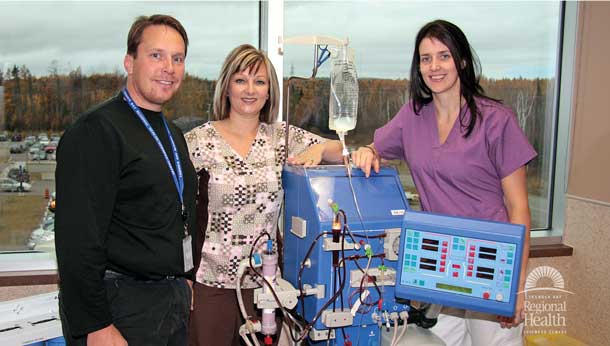
2008: First Home Hemodialysis Patients
THUNDER BAY – Many patients with permanent loss of kidney function depend on hemodialysis, a lifesaving treatment that essentially performs the regular functions of healthy kidneys by cleaning blood and removing wastes and excess water from the body. The patient is attached to a dialysis machine and the blood is cleaned three times a week for three to four hours as the blood travels through the dialysis machine.
In 2008, Thunder Bay Regional Health Sciences Centre (TBRHSC) began to offer “Home Hemodialysis” to patients, training them in the newly constructed space in the Medical Centre. This allowed patients to do their own treatment in the comfort of their own homes instead of coming to the Health Sciences Centre several times a week.
This patient-centred approach has also allowed many dialysis patients to regain control over their lives. TBRHSC’s first home hemodialysis patients reported that the freedom to clean their blood in the comfort of their own homes was like getting a new lease on life. Patients can plan their days to be full of activity and still attend to dialysis later in the day in the convenience of their own homes.
“Although the Home Hemodialysis program was launched one year before TBRHSC formally adopted the Patient and Family Centred Care model, it clearly demonstrated our commitment to PFCC values of being respectful of, and responsive to individual patient/family preferences, needs, and values,” says Dr. Mark Henderson, Executive Vice President, Chronic Disease Prevention and Management, TBRHSC.
Patients doing the treatment at home must undergo a training period of about eight weeks at the hospital. A nurse and biomedical technician go to each patient’s home to set up the equipment and assist with the first home treatment. Patients must then attend the hospital every six to eight weeks for assessment by the multidisciplinary team that includes nurses, coordinators, dietitian, pharmacist, social workers, native liaison worker, staff educator and nephrologists.
Also in 2008:
- Thunder Bay Regional Research Institute announced its research focus on Imaging Guided Interventions; Advanced Detection Devices; and Biomarker Exploration, to develop imaging systems to aid in the diagnosis and treatment of chronic diseases and to customize and optimize individual therapy;
- The Northern Cancer Research Foundation and the Thunder Bay Regional Health Sciences Foundation joined forces to increase focus on meeting the needs of all patients;
- Medical learners, 4th year medical students, and clinical clerks began training at TBRHSC.











